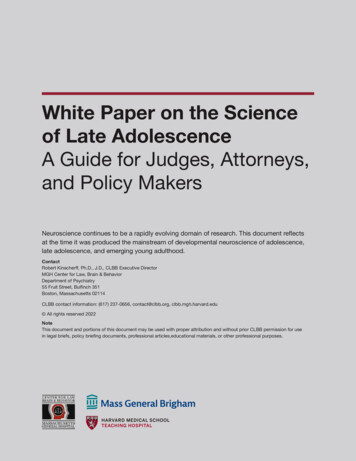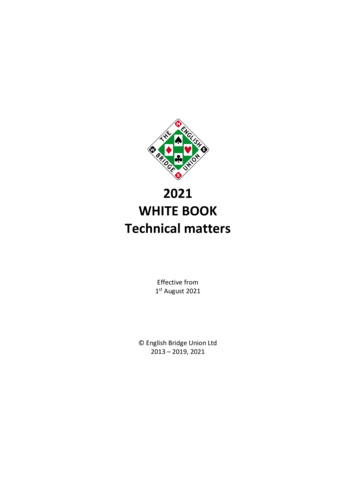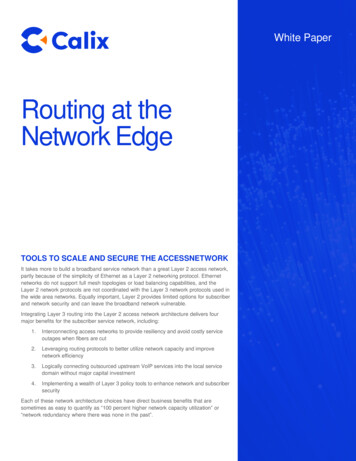
Transcription
White Paper on the Scienceof Late AdolescenceA Guide for Judges, Attorneys,and Policy MakersNeuroscience continues to be a rapidly evolving domain of research. This document reflectsat the time it was produced the mainstream of developmental neuroscience of adolescence,late adolescence, and emerging young adulthood.ContactRobert Kinscherff, Ph.D., J.D., CLBB Executive DirectorMGH Center for Law, Brain & BehaviorDepartment of Psychiatry55 Fruit Street, Bulfinch 351Boston, Massachusetts 02114CLBB contact information: (617) 237-0656, contact@clbb.org, clbb.mgh.harvard.edu All rights reserved 2022NoteThis document and portions of this document may be used with proper attribution and without prior CLBB permission for usein legal briefs, policy briefing documents, professional articles,educational materials, or other professional purposes.
Authorship andAcknowledgementsCenter for Law, Brain & Behavior White Paper Project TeamCatherine Insel,* PhDPostdoctoral Research Fellow, Zuckerman Institute, ColumbiaUniversityStephanie Tabashneck,* PsyD, JDForensic Psychologist; 2022 Senior Fellow in Law andApplied Neuroscience, joint Fellowship of CLBB and PetrieFlom Center, Harvard Law SchoolFrancis X. Shen, JD, PhDProfessor of Law and McKnight Presidential Fellow,University of Minnesota Law School; CLBB Faculty MemberJudith G. Edersheim, JD, MDAttending Psychiatrist, Massachusetts General Hospital;Assistant Professor of Psychiatry, Harvard Medical School;CLBB Founder and Co-DirectorRobert T. Kinscherff, PhD, JDProfessor, Doctoral Clinical Psychology Program at WilliamJames College; CLBB Executive Director*First authorsManuscript ReviewersArielle Baskin-Sommers, PhDAssociate Professor of Psychology and of Psychiatry, YaleUniversityMariah BellamorosoStudent, Harvard Law SchoolLisa Feldman Barrett, PhDUniversity Distinguished Professor of Psychology,Northeastern University; CLBB Chief Scientific OfficerHon. Jay D. Blitzman, JDFirst Justice-Massachusetts Juvenile Court, Middlesex Division(Ret.); CLBB Faculty MemberBJ Casey, PhDProfessor of Psychology, Affiliated Professor of the JusticeCollaboratory and Interdepartmental Neuroscience Program,Director of the Fundamentals of the Adolescent BrainLaboratory, Yale UniversityAlexandra Cohen, PhDPostdoctoral Fellow, Department of Psychology and Center forNeural Science, New York UniversityAdriana Galván, PhDProfessor, Jeffrey Wenzel Term Chair in BehavioralNeuroscience, Department of Psychology, Universityof California at Los AngelesMelanie Grad-Freilich, BSLab Manager for the Affective Neuroscience and DevelopmentLab, Harvard UniversityHon. Nancy Gertner, JD, MASenior Lecturer on Law, Harvard Law School; Judge (Ret.),United States District Court for the District of Massachusetts;CLBB Managing DirectorAdam Haar Horowitz, PhD CandidateMassachusetts Institute of Technology Media Lab; CLBBAdvisory Board MemberMarsha Levick, EsqChief Legal Officer, Juvenile Law CenterShobha L. Mahadev, JDChildren and Family Justice Center, Bluhm Legal Clinicat Northwestern Pritzker School of LawBruce H. Price, MDChief, Department of Neurology, McLean Hospital; AssociateProfessor in Neurology at Harvard Medical School; CLBBFounder and Co-DirectorLeah H. Somerville, PhDProfessor of Psychology and Director of the AffectiveNeuroscience and Development Laboratory, HarvardUniversity; CLBB Faculty MemberElyssa A. L. Spitzer, JD2021 Senior Fellow in Law and Applied Neuroscience, jointFellowship of CLBB and the Petrie-Flom Center, Harvard LawSchool
Center for Law, Brain & BehaviorResearch AssistantsElizabeth Escalante, BSCognitive Science, Tufts UniversityNajet Miah, BAPsychology, Queens College, City University of New YorkKatherine FangStudent, Yale Law SchoolMadeleine Muller, BAPsychology, Northwestern UniversityIan HayesStudent, Harvard CollegeJennifer NearStudent, Harvard CollegeAnnie IlsleyStudent, Duke UniversityKailey NicholsonStudent, Harvard CollegeShreyas IyerStudent, Harvard CollegeJob OkeriStudent, University of Minnesota Law SchoolClarissa KimmeyStudent, Yale Law SchoolIfeoma Okoli, BAPsychology, Harvard CollegeSarah Lagan, BANeuroscience, Harvard CollegeErin Shortell, JD, MPHStudent, Harvard Law School and Harvard T.H. ChanSchool of Public HealthLayla MalamutStudent, Yale Law SchoolFenella McLuskieStudent, Harvard Law SchoolLeonard Alexander Walker IIIStudent, Harvard Law SchoolSpecial thanks to members of the Research Network on Law and Neuroscience, supportedby the John D. and Catherine T. MacArthur Foundation, and others who participated inthe working meeting: “The Science of Emerging Adulthood: What do we know and how mightthis knowledge be appropriately applied in the law?” virtually convened at Harvard onSeptember 30, 2020. We are particularly grateful to those who offered their consultation andreview during drafting this document.Grateful acknowledgement to the CLBB Advisory Board whose support made this projectpossible. We especially thank Jim Joslin who has generously contributed to support CLBBand its work to advance juvenile and emerging adult justice.Finally, our thanks to Emily Rehmet, BA, Cognitive Neuroscience and Public Policy, BrownUniversity; Project Manager, Massachusetts General Hospital Center for Law, Brain andBehavior, whose organizational skills, patience, input and supports in keeping us focusedsubstantively contributed to completion of this project.Cite as:Center for Law, Brain & Behavior at Massachusetts General Hospital (2022). White Paper on the Science of Late Adolescence: AGuide for Judges, Attorneys and Policy Makers (January 27th, 2022). ience of-late-adolescence/Errata Corrected: February 2, 2022
Table of Contents15Executive SummaryIntroduction3840Section I: Miller Factor 1 Immaturity, Impetuosity, Risk-takingA. Executive FunctioningB. Hot/Cold Cognition and Reward SensitivityC. Long-term Planning and Future Oriented Decision-makingSection II: Miller Factors 2 and 3 Family and Home, Peer InfluenceA. Impact of Adversity on Late Adolescent Brain DevelopmentB. Impact of Adversity on Late Adolescent Behavioral and Health OutcomesC. Social Determinants of Late Adolescent WellbeingD. Late Adolescent Sensitivity to Peer InfluenceE. SummarySection III: Miller Factor 4 Understanding Legal ProceedingsA. Neurocognitive Processes Underlying Late Adolescent Decision-making1. Future Oriented Decision-Making2. Decision-making Under StressB. Decision-making in Legal ContextsC. False Confessions1. False Self-Incrimination2. False Memory and Peer Influence3. Contextual Influences and Individual Differences.Section IV: Miller Factor 5 Greater Potential for RehabilitationA. Adolescent Brains Are Poised for LearningB. Middle and Late Adolescent Behavior Patterns and Emerging Personality FeaturesAre More Malleable Than Those of AdultsC. Adolescence Gives Rise to Developmentally Expectable Changes in BehaviorD. Personality Continues to Change Across the Lifespan42Conclusion and Recommendations46474748505152545658Appendix: Introduction to Middle and Late Adolescent Brain DevelopmentA. Fundamentals of Late Adolescent Brain Development1. Structural Development2. Grey Matter Development3. White Matter Development4. Functional DevelopmentB. Emotional Influences on Cognition in the Late Adolescent BrainC. Development of the Brain’s Learning and Reward SystemsD. Social Influence Impacts Late Adolescent Brain ResponsesE. 7
Executive SummaryThe United States Supreme Court decision in Jones v. Mississippi (2021)1 almost certainly signals the end of further expansion at this time by SCOTUS of Eighth Amendment protections tojuveniles.2 Jones v. Mississippi held that a sentencing court need not make a specific findingthat a youth is “permanently incorrigible” or even articulate a specific Miller v. Alabama rationale for a sentencing decision guided by factors provided in Miller v. Alabama.3 It was enoughthat the sentencing judge understood that he or she had discretion to consider the Miller factors and made an individualized sentencing decision—a very low bar.4In addition, the legal framework established by the Roper-Graham-Miller-Montgomery line ofSCOTUS cases in barring execution for juvenile capital offenses,5 Life Without Parole (JLWOP)for juvenile non-homicide cases,6 and mandatory LWOP for juvenile homicide cases7 has beenincorporated to varying degrees into state statutes and case law and offers at least the possibility for a more robust application of Miller. The Miller approach also remains viable forpursuing expansion of those categorical protections to age 18 and beyond, and perhaps forraising the age of full criminal culpability.The Miller framework’s focus on “transient immaturity” also offers a way of asserting protections for young offenders in individual cases.8 Arguably, shifting the focus from “permanentincorrigibility” (which cannot be predicted in a scientifically reliable manner) to “transient immaturity” (which is already established by robust developmental research and neuroscience) mayprovide opportunities for counsel and courts at trial/sentencing phases and upon appellatereview. It may also encourage prosecutors to consider research-based diversion and community-based intervention programs as alternatives to traditional charging decisions and sentencingrecommendations.Similarly, the explicit reliance in these SCOTUS cases upon developmental neuroscience andbehavioral science offers models for using science to advance broad evidence-based law andpolicy reforms regarding juveniles and emerging young adults. This White Paper reports the latest developmental and brain science to inform judges, attorneys, and policy makers about1 Jones v. Mississippi, 141 S. Ct. 1307 (2021).2 For purposes of this White Paper, the following terms are used to describe young people of different ages: (a) juveniles:broadly, persons between 13–17; (b) early adolescents: persons ages 10–13; (c) middle adolescents: persons ages 14–17;(d) late adolescents: persons ages 18–21; and (e) young adults: persons ages 22–25.3 Jones, 141 S. Ct. at 1311.4 Id.5 Roper v. Simmons, 543 U.S. 551 (2005).6 Graham v. Florida, 560 U.S. 48 (2010).7 Miller v. Alabama, 567 U.S. 460 (2012); Montgomery v. Louisiana, 577 U.S. 190, 211 (2016) (extending Miller retroactively).8 Miller, 567 U.S. at 479.1
critical research developments.9 This White Paper is intended to facilitate science-informeddecision-making and application of updated research findings in law and public policy bearingupon adolescence and criminal proceedings.In the landmark case Miller v. Alabama (2012), the United States Supreme Court eliminatedmandatory life-without-parole sentences for murders committed by youth under age 18.10 Thisdecision was informed by an evolving understanding of adolescent brain development andbehavioral research. Since then, scientific research has emerged which reinforces the reasoning of the Miller decision and, if its implications are accepted, extends much of the science thatresonated with the Miller court to late adolescents (ages 18–21).Maturation of brain structure, brain function, and brain connectivity continues throughout theearly twenties.11 This ongoing brain development has profound implications for decision-making, self-control and emotional processing. For example, new neuroscience research revealsthat during emotionally charged situations, late adolescents (ages 18–21) respond more likeyounger adolescents (ages 13–17) than like young adults (ages 22–25) due to differences inbrain maturation.12Compared to young adults above age 21, late adolescents (ages 18–21) also take more risksand engage in more sensation-seeking behavior.13 Due to differences in brain development, lateadolescents are more likely than young adults to respond to immediate outcomes and are lesslikely to delay gratification.14 The presence of peers can intensify these behaviors, and thebrains of late adolescents are more responsive to peer involvement than those of youngadults.15 Late adolescents are also more easily swayed by adult influence and coercion thantheir adult counterparts.16 These developmental differences in behavior have direct implicationsfor legal decision-making, including waiving Miranda rights, susceptibility to false confessions,and making ill-advised trial decisions (e.g., plea decisions).9 See Appendix A for a foundational review of the science. For an extensive review of brain and socio-behavioral research andits policy implications, see also National Academies of Sciences, Engineering, and Medicine, The Promise of Adolescence:Realizing Opportunity for All Youth. (2019), https://doi.org/10.17226/25388; Institute of Medicine and National ResearchCouncil, Investing in the Health and Well-Being of Young Adults (2015), https://doi.org/10.17226/18869.10 Miller, 567 U.S. at 480.11 Leah Somerville, Searching for Signatures of Brain Maturity: What Are We Searching For?, 92 Neuron 1164, 1164–67 (2016).12 Alexandra O. Cohen et al., When Is an Adolescent an Adult? Assessing Cognitive Control in Emotional and NonemotionalContexts, 27 Psych. Sci. 549 (2016); Marc D. Rudolph et al., At Risk of Being Risky: The Relationship Between “Brain Age”Under Emotional States and Risk Preference, 24 Developmental Cognitive. Neurosci., 93, 93–106 (2017); B. J. Casey et al,Development of the Emotional Brain, 29 Neurosci. Letters 693 (2019).13 Laurence Steinberg, Adolescent Brain Science and Juvenile Justice Policymaking, 23 Psych., Pub. Pol’y, & L. 410 (2017).14 Michelle Achterberg et al, Frontostriatal White Matter Integrity Predicts Development of Delay of Gratification: A LongitudinalStudy, 36 J. Neurosci. 1954 (2016); Samuel Hawes et al, Modulation of Reward-Related Neural Activation on SensationSeeking Across Development, 147 Neuroimage 763 (2017).15 Dustin Albert, Jason Chein & Laurence Steinberg, The Teenage Brain: Peer Influences on Adolescent Decision-Making, 22Current Directions Psych. Sci. 114 (2013); Ashley Smith et al, Age Differences in the Impact of Peers on Adolescents’ andAdults’ Neural Response to Reward, 11 Developmental Cognitive Neurosci. 75 (2015).16 Hayley Cleary, Applying the Lessons of Developmental Psychology to the Study of Juvenile Interrogations: New Directions forResearch, Policy, and Practice, 23 Psych., Pub. Pol’y, & L., 118, 118–130 (2017).Executive Summary2
Adversity, racism, and poverty also have a profound impact on health, quality of life, and criminal justice involvement.17 As discussed below, adolescents who have experienced adversity,racism, and poverty are significantly overrepresented in juvenile and criminal justice systems.However, while these experiences pose developmental challenges, they do not dictate fate, aslate adolescents are also remarkably resilient, and their developing brains are poised for positive learning through interventions and rehabilitation.18For late adolescents engaged in criminal behavior, research consistently indicates that mostwill not continue to offend and become adult repeat offenders through their twenties, thirties,and beyond.19 This has significant implications for both policy and the legal system. For example, this high rate of desistance from even serious or persistent adolescent offending as youthmove into their early to mid-twenties renders it impossible to reliably predict, based on currentscience, which individual youth will continue to offend into adulthood and which will desist asthey mature. There is certainly no basis in science to reliably determine that an individual youthat the time of sentencing in adolescence is incapable of rehabilitation (or even unlikely toachieve it) over the course of a lifetime.While Jones v. Mississippi (2021) held that a sentencing court need not make a formal findingof “permanent incorrigibility” in considering a JLWOP sentence,20 the Miller factors remainapplicable and key to articulating the “transient” nature of adolescence generally and applyingthose factors in the individual case before the court. Science cannot divine which “rare” adolescent may be “permanently incorrigible,” but it can identify the characteristically “transientcharacteristics” of adolescence.One inherent challenge to incorporating science into litigation and decision-making lies in theapplication of research developed in studies on groups of subjects to the circumstances, conduct, and developmental trajectories of individual persons before the court. This is sometimesreferred to as the “Group to Individual” conundrum. For example, developmental brain sciencecan provide “on average” group-level descriptions of brain development and maturation whichcan be supplemented by consideration of the specific individual characteristics at issue in thelegal context. This, of course, is a challenge that is familiar in the practice of medicine, wherephysicians must apply research based upon groups to diagnose and treat individuals.In cases involving adolescents and late adolescents, research applied in individual cases mustbe derived from studies in multiple domains including neuroscience, social determinants ofmisconduct, peer affiliations and social networks, developmental trajectories, and individualcharacteristics (e.g., cognitive capacities, physical maturation, emotional charac-teristics,learning style, family dynamics).17181920Scott Lorch & Elizabeth Enlow, The Role of Social Determinants in Explaining Racial/Ethnic Disparities in Perinatal Outcomes79 Pediatric Rsch. 141 (2016).B.J Casey et al, Making The Sentencing Case: Psychological and Neuroscientific Evidence for Expanding the Age of YouthfulOffenders, 5 Ann. Rev. Criminology (forthcoming 2022).Off. Juv. Just. Delinq. Prot., Law Enforcement & Juvenile Crime: Arrests by Offense, Age, and Gender, U.S. Dept. Just. (Oct.21, 2019), https://www.ojjdp.gov/ojstatbb/crime/ucr.asp?table in 1 [https://perma.cc/T6H7–3LWX].Jones v. Mississippi, 141 S. Ct. 1307, 1309 (2021).Executive Summary3
This Guide is intended to support attorneys and judges in familiarizing themselves with thecontours of the relevant science and how it can be applied to individual cases. A workingknowledge of developmental and brain science allows attorneys and judges to make best useof what a juvenile defendant’s life course, circumstances of an alleged offense, and expertevaluations and opinions can tell them to assist in understanding a defendant.21 For attorneys,this facilitates preparing a case, educating the legal finder of fact, and making optimal use ofexpert testimony. For judges, this facilitates science-informed decision-making at all trial andappellate phases of a case involving a juvenile or young adult.22The goal is to position each individual young defendant within a developmental trajectory comprised of biological, psychological, and social domains. A significant majority of cases willultimately reflect “transitory immaturity,” a feature of adolescence which will resolve as adolescents mature, resulting in desistance from criminal misconduct. Science-informeddecision-making and evidence-based interventions can guide rehabilitation and reduce recidivism (thereby improving community safety) while avoiding or minimizing the negative impact ofcommon responses (such as overuse of detention and incarceration) that can inadvertentlycompromise positive youth development and increase recidivism.A better understanding of late adolescent brain and behavioral development can transformhow the legal system and policy makers respond to late adolescents who offend. By educatingdecision-makers and advocates, this White Paper informs the criminal justice system and policy makers through providing an updated research perspective on late adolescence andsupporting public safety by reducing recidivism through developmentally aligned accountabilityand empirically based processes and interventions.21 Readers conducting forensic evaluations or using these evaluations in legal proceedings can find guidance in generating orrelying upon them from sources including Antoinette Kavanaugh & Thomas Grisso, Evaluations for Sentencing of Juveniles inCriminal Court (2020).22 For a review of aspects of “developmental evidence” and application of the Miller factors, see Thomas Grisso & AntoinetteKavanaugh, Prospects for Developmental Evidence in Juvenile Sentencing Based on Miller v. Alabama, 22 Psych. Pub. Pol’y &L. 235, 235–249 (2016); See also Thomas Grisso, Three Opportunities for the Future of Juvenile Forensic Assessment, 46Crim. Just. & Behav. 1671 (2019), https://doi.org/10.1177/0093854819883671Executive Summary4
JuvenilesEarly AdolescenceMiddle AdolescenceLate AdolescenceYoung AdultsAges 13–17Ages 10–13Ages 14–17Ages 18–21Ages 22–25Age Ranges Defined for Purposes of this White PaperIntroductionIn a series of landmark decisions starting in 2005, the United States Supreme Court ruled thatno one can be put to death,23 receive a sentence of Life Without Parole for a non-homicideoffense,24 or receive a sentence of mandatory Life Without Parole for an offense committedprior to age 18.25In drawing the line at age 18, the Supreme Court continued a tradition of raising the age atwhich Eighth Amendment protections against cruel and unusual punishment are applied.As Justice Stevens recognized in his concurring opinion in Roper v. Simmons, the holdingreaffirmed the principle that “evolving standards of decency have driven [the Court’s]construction of this critically important part of the Bill of Rights,” and recognized that “[i]f themeaning of that Amendment had been frozen when it was originally drafted, it would imposeno impediment to the execution of 7-year-old children today.”26Jones v. Mississippi (2021) held that the requirements of Miller v. Alabama (2012) are satisfied ifa juvenile’s sentence of Life Without Parole (JWOP) is imposed after an individualized hearing.Notably, the Jones majority did not reinforce the Miller court’s view that this sentence shouldbe “uncommon” and reserved for the “rare” youth deemed “permanently incorrigible.” Indeed,the Jones decision held that a sentencing judge need not make a specific finding that a juvenileis “permanently incorrigible” or even make formal findings of fact in support of a discretionarysentencing decision. However, SCOTUS did not explicitly strike down the Miller factor framework, acknowledged that states may set their own standards and protections more stringentlythan the Jones approach27 (which many states have), and left undisturbed the concept of the“transient immaturity” of youth reflected in decisions from Roper (2005) through Montgomery v.Louisiana (2016).2823 Roper v. Simmons, 543 U.S. 551 (2005).24 Graham v. Florida, 560 U.S. 48 (2010).25 Miller v. Alabama, 567 U.S. 460 (2012).26 Roper, 543 U.S. at 1205.27 Jones v. Mississippi, 141 S. Ct. 1307, 1322 (2021).28 Montgomery v. Louisiana, 136 S. Ct. 718 (2016)5
The Jones court abandoned any consideration of “evolving standards of decency” that mightlead to the abolition of JLWOP outright, although case law and statutes in many states sinceMiller have taken that step. Other states have established minimum sentences29 to be servedbefore juvenile homicide offenders are afforded the requirement set by the Miller court for a“meaningful” opportunity to demonstrate that they have achieved rehabilitation.The Jones court paid scant attention to the scientific foundations of the Roper throughMontgomery line of cases. By contrast, prior to the dilution by Jones of protections afforded tojuvenile offenders, SCOTUS Eighth Amendment rulings about sentencing youthful offendershad drawn heavily from advances in social sciences and neurodevelopmental research.30 TheCourt cited scientific publications when it ruled that the Eighth Amendment prohibits the deathpenalty for those under age 18 at the time of their capital offense;31 prohibits life without thepossibility of parole (LWOP) for non-homicide offenders under age 18 at the time of theiroffense;32 and prohibits mandatory life imprisonment without parole for those under age 18 atthe time of the offense, even for homicide offenses.33From those scientific studies it cited, the Court reached the conclusion that youth are less morally culpable, more susceptible to peer pressure, and more amenable to positive change.Indeed, SCOTUS had absolutely barred for juveniles as a class both execution and life withoutpossibility of parole for non-homicide offenses, reflecting a strong “children are different”approach to Eighth Amendment constitutional doctrine.The Miller majority stepped back from this categorical “children are different” approach when itbarred mandatory LWOP but permitted it for a presumably very small number of “permanentlyincorrigible” youth based on a judge’s discretion following an individualized sentencing hearing.In doing so, however, the Miller Court reaffirmed the law’s recognition that “relevance of youthas a mitigating factor derives from the fact that the signature qualities of youth are transient; asindividuals mature, the impetuousness and recklessness which may dominate in younger yearscan subside.”34Although the Jones majority did not focus upon the “transient immaturity” of youth, legislativeand case law developments among the states implementing Miller suggest the concept of“transient immaturity” may be central to incorporating into litigation and policy advocacy thecontinuing developments in science. While there is no scientifically reliable basis to predict thata youthful offender is “permanently incorrigible,” there is a robust scientific basis, as described29 Litigation continues to clarify at what point a lengthy minimum mandatory sentence for a juvenile offender violates the Millerrequirement there be afforded a “meaningful” opportunity to demonstrate achievement of rehabilitation. The disparity amongstates of minimum mandatory terms to be served range from less than two decades to four or more decades, resulting in aproblematic “justice by geography” situation where sentenced youthful offenders may serve sentences for the same offensesthat differ by decades before a putatively “meaningful” case review.30 See, e.g., Miller, 567 U.S. at 471 (noting relevance of studies in Am. Psychologist and other journals for the reasoning inRoper and Graham).31 Roper v. Simmons, 543 U.S. 551 (2005).32 Graham v. Florida, 560 U.S. 48 (2010). Graham held that states must provide “meaningful opportunity to obtain release basedon demonstrated maturity and rehabilitation.” Id. at 75.33 Miller 567 U.S. at 460.34 Id. at 1195–96 (internal citations omitted).Introduction6
in this Guide, to identify the “transient immaturity” of youth and emerging young adults and thenormal process of self-desistence from criminal misconduct that occurs with maturation. TheMiller factors still serve as a framework for organizing and explaining this research and as ameans for accounting for the hallmarks of youthful immaturity, the circumstances of theiroffenses, and their greater prospects for self-desistence with maturation alone or with the support of empirically-based interventions.This White Paper reviews recent scientific research establishing that these same “signaturequalities of youth” extend into the period of late adolescence (ages 18–21). Since the SupremeCourt decided Miller v. Alabama in 2012, more than one hundred new publications haveexplored the brain’s development throughout late adolescence. Over 1,000 legal cases havereferenced the same or similar neuroscience to that discussed in Miller, with many citing newerscientific articles as well.35 Roughly half of these cases concerned individuals who were 18years old or older at the time of the offenses for which they were charged.In addition to their implications for legal challenges, the scientific findings reported in this WhitePaper are relevant for criminal justice policy. Late adolescents (ages 18–21) and young adults(ages 22–25) make up approximately 10–12% of the U.S. population,36 yet this age groupaccounts for 23% of all arrests.37 Late adolescents also make up 20% of incarcerated persons.38 Youth of color are disproportionately represented,39 as half of incarcerated 18–2435 Francis X. Shen, et al., Justice for Emerging Adults after Jones: The Rapidly Developing Use of Neuroscience to Extend EighthAmendment Miller Protections to Defendants Ages 18 and Older, 97 N.Y.U. L. Rev. Online (forthcoming 2022) (examining howthe science proffered in Miller has been cited in subsequent cases).36 Population estimates vary depending upon demographic data sources and years the samples were derived. See Just. PolicyInst., Improving Approaches to Serving Young Adults in the Justice System 3 (2016) (9.9% of U.S. population); see also AnnieE. Casey foundation, Kids Count Data Center https://datacenter.kidscount.org/ (last visited April, 17, 2021) (similar).Alternatively, one could calculate this percentage by combining population data sources: for example, the U.S. CensusBureau projected a total U.S. population of 326,971,407 on January 1, 2018. U.S. Census Bur., Census Bureau Projects U.S.and World Populations (Dec. 28, 2017), 7/new-years-2018.html[https://perma.cc/8MKP-FUHU]. The Center for Education Statistics estimated a population of 30,600,000 18- to 24-year-oldsfor the same date. Nat’l Ctr. For Ed. Statistics, Indicator 1: Population Distribution (Feb. 2019), tor RAA.asp [https://perma.cc/9XZQ-YRY9] (last visited Dec. 12, 2020). 30,600,000 divided by326,971,407 equals about 9.36%.37 See Office of Juvenile Justice and Delinquency Prevention, Estimated number of arrests by offense and age group, U.S. Dep’tof Justice (2019), https://www.ojjdp.gov/ojstatbb/crime/ucr.asp?table
Flom Center, Harvard Law School Francis X. Shen, JD, PhD Professor of Law and McKnight Presidential Fellow, University of Minnesota Law School; CLBB Faculty Member. . decision-making and application of updated research findings in law and public policy bearing upon adolescence and criminal proceedings. In the landmark case .










![[CLASS XII CHEMISTRY PRACTICALS]](/img/23/xii-chemistry-practical.jpg)
